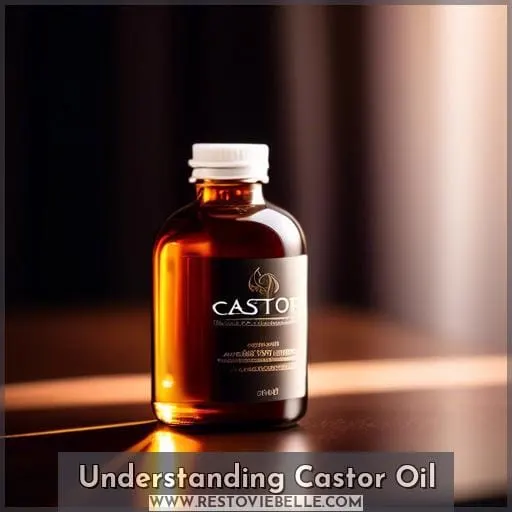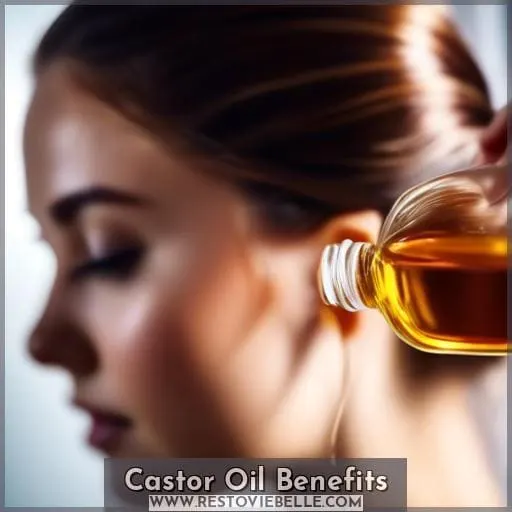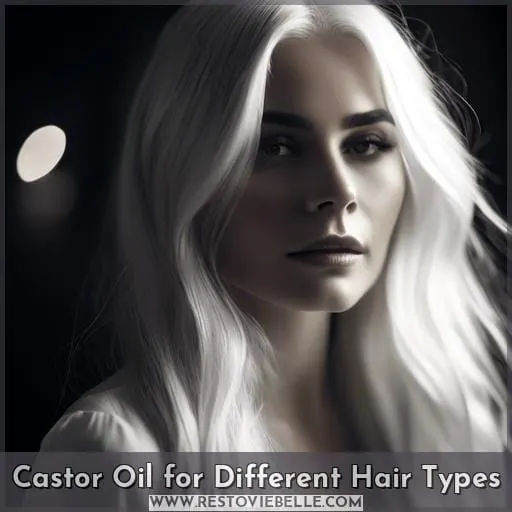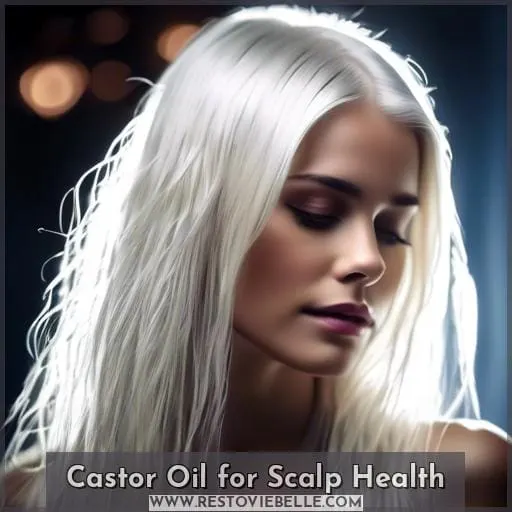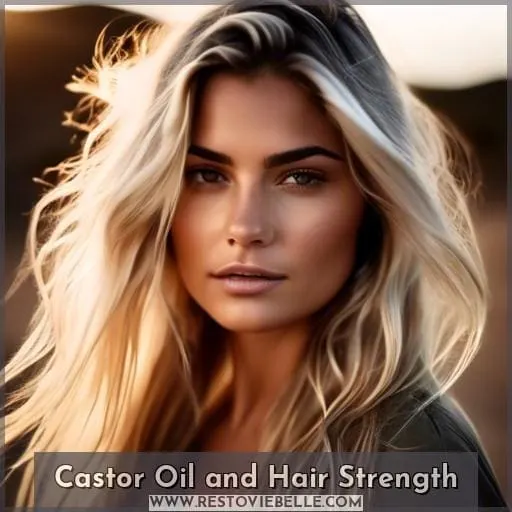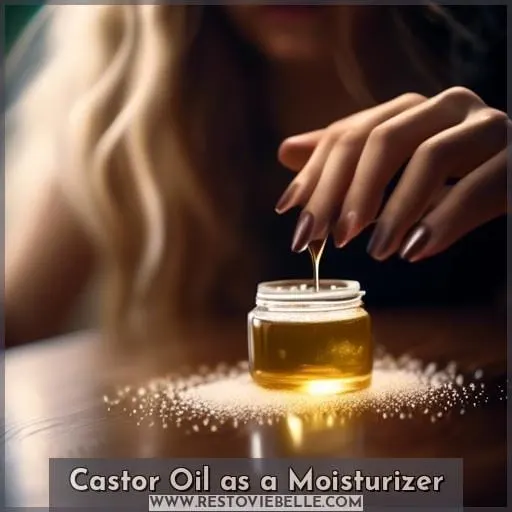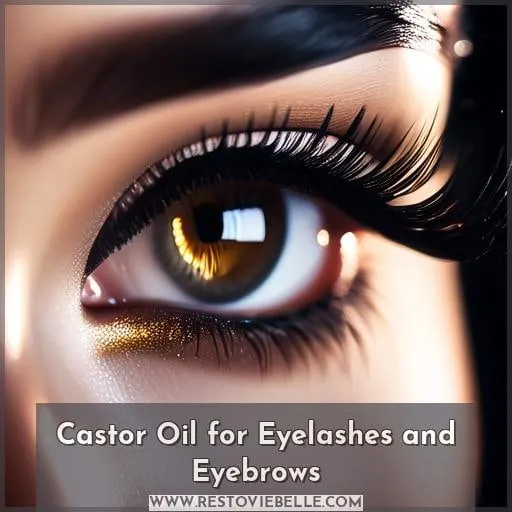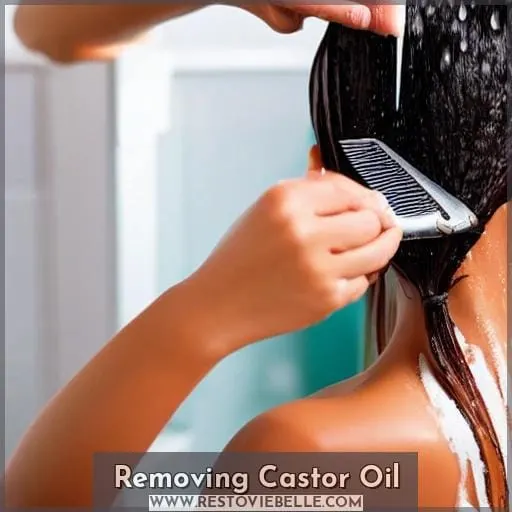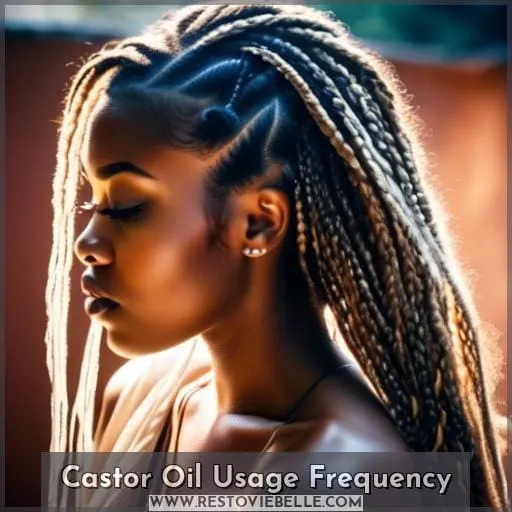This site is supported by our readers. We may earn a commission, at no cost to you, if you purchase through links.
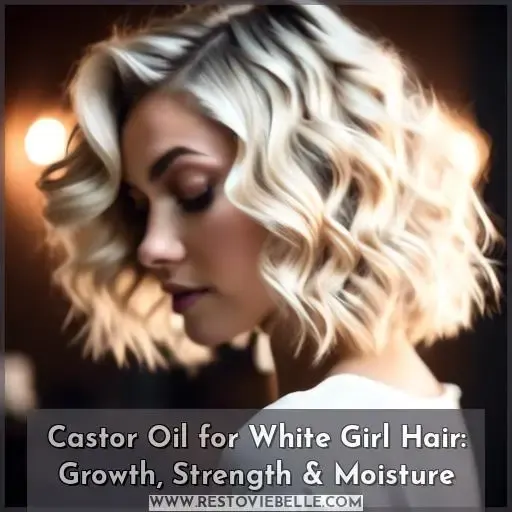 Discover the ancient elixir that’s been transforming hair for centuries—castor oil. This powerhouse oil isn’t just a trend; it’s a tradition with deep roots in beauty rituals worldwide, now making waves in modern hair care.
Discover the ancient elixir that’s been transforming hair for centuries—castor oil. This powerhouse oil isn’t just a trend; it’s a tradition with deep roots in beauty rituals worldwide, now making waves in modern hair care.
Whether you’re battling dryness, seeking strength, or dreaming of length, castor oil is your go-to. Its rich composition, brimming with ricinoleic acid and essential fatty acids, offers a feast of nourishment for your locks.
Dive into the world of castor oil for white girl hair, where growth, strength, and moisture are not just possibilities but promises.
Table Of Contents
- Key Takeaways
- Understanding Castor Oil
- Castor Oil Benefits
- Castor Oil Application
- Castor Oil for Different Hair Types
- Castor Oil for Scalp Health
- Castor Oil and Hair Strength
- Castor Oil as a Moisturizer
- Castor Oil for Eyelashes and Eyebrows
- Removing Castor Oil
- Castor Oil Usage Frequency
- Frequently Asked Questions (FAQs)
- Conclusion
Key Takeaways
- Castor oil is suitable for all hair types, including Caucasian hair, and can be used to moisturize, condition, and promote hair growth.
- It contains ricinoleic acid and fatty acids, which are beneficial for hair strength, scalp health, and adding luster and thickness to hair.
- For optimal application, it can be mixed with lighter oils for easier application and should be massaged into the scalp to stimulate circulation.
- Castor oil has been traditionally used for thousands of years and is recognized for its ability to combat scalp inflammation, fight scalp conditions, and moisturize both the scalp and hair.
Understanding Castor Oil
Understanding Castor Oil
Castor oil has a storied history, dating back to its use in traditional medicine and as a laxative in ancient civilizations. Harvested from the seeds of the Ricinus communis plant, castor oil extraction is a meticulous process that ensures the preservation of its unique properties. The oil is primarily composed of ricinoleates, accounting for about 90% of its fatty acid content, with oleic and linoleic acids also present in smaller amounts.
In cosmetics and medicine, castor oil’s uses are extensive due to its antibacterial and anti-inflammatory properties. It’s been shown to improve hair growth by increasing scalp circulation, and it also conditions and moisturizes hair across various hair types.
When applying castor oil, it’s recommended to mix it with lighter oils like coconut or jojoba to enhance its texture and aroma, and to apply it in moderation to avoid difficulties with removal.
The benefits of castor oil for hair include reversing damage, balancing scalp pH, and promoting hair growth. For white girl hair, or any hair type, it can add luster and thickness to the strands. However, it’s important to test for allergies and use proper application methods to avoid adverse effects.
Castor Oil Benefits
You’ve likely heard about the wonders of castor oil for hair care, especially for those with white girl hair seeking growth, strength, and moisture.
Castor oil is renowned for its conditioning properties, which can improve scalp circulation and contribute to healthier hair growth.
It’s important to approach its use with knowledge of your hair and scalp needs, as it can be particularly beneficial for those with dry or damaged hair.
Hair Growth Claims
Castor oil is renowned for stimulating hair growth. The ricinoleic acid may boost circulation to your follicles, while the omega fatty acids nourish them.
Many report increased thickness and length when using castor oil. For optimal results, focus on your hair porosity and growth patterns.
Massage the oil into your scalp and along the hair shaft. Be patient – you may notice changes in as little as 2 weeks.
Conditioning Properties
Jamaican Black Castor Oil (JBCO) is renowned for its numerous benefits for hair care, which include moisturizing, thickening, strengthening, repairing damaged hair, and encouraging hair growth. These benefits are attributed to its rich content of ricinoleic acid and other fatty acids, which act as natural emollients for the hair.
JBCO’s versatility makes it suitable for all hair types, including curly, kinky, and straight, and it’s beneficial for people of all ethnicities and both sexes. It can address various hair issues such as dryness, damage, thinning, and baldness.
Success stories from individuals like Amber, Ashley, and Vincent highlight the oil’s effectiveness across different hair types and conditions. They reported noticing results within the first two weeks, with reduced hair fall and new eyelash growth.
JBCO is 100% natural, suitable for all hair and skin types, and is processed using traditional Jamaican methods without the use of salt. Its color ranges from golden brown to dark brown. When using JBCO, it’s recommended to apply it to the hair and scalp, massage it in, leave it on for at least 30 minutes, and then rinse it out.
However, due to its high viscosity, it can be difficult to remove if applied excessively, and it may leave stains on clothes. To avoid this, it can be mixed with lighter oils like jojoba or coconut oil, and care should be taken to use an applicator bottle for precise application to the scalp.
In terms of availability, JBCO can be purchased through product links provided and is widely available. Testimonials from users like Amber, Ashley, and Vincent provide personal accounts of the benefits they experienced using JBCO, such as moisturized and healed damaged hair, reduced hair fall, and filled-in bald spots.
Castor Oil Application
When incorporating castor oil into your hair care routine, it’s essential to understand how to apply it effectively to maximize its benefits.
Mixing castor oil with other oils, such as coconut or jojoba, can enhance its nourishing properties and make it easier to work with, especially for those with finer hair textures.
Scalp massage techniques, utilizing gentle circular motions, can stimulate blood flow to the hair follicles, promoting healthier hair growth and strength.
Regular application, following these methods, can lead to noticeable improvements in hair texture and overall scalp health.
Mixing With Other Oils
When mixing castor oil with other oils, consider the specific needs of your hair and scalp.
For a pre-poo treatment or to address dry hair, blend castor oil with lighter oils like jojoba or coconut oil to reduce its viscosity and strong odor. This also makes application techniques more manageable and ensures better hair type compatibility.
The omega-9 fatty acids in castor oil are excellent for hair regeneration and scalp treatment. Adjust mixing ratios to suit your hair’s density and porosity, aiming for odor reduction without compromising the oil’s beneficial properties.
Scalp Massage Techniques
To boost scalp circulation and stimulate hair follicles, massage castor oil into your scalp for 5-10 minutes using light, circular motions with your fingertips.
Vary pressure and focus on areas of thinning. This massage duration and technique improves circulation to hair follicles, delivering nutrients that encourage new growth.
Be gentle to avoid irritation.
Castor Oil for Different Hair Types
Castor oil’s versatility extends to all hair types, offering numerous health benefits that can enhance your beauty routine. Its rich composition, including ricinoleic acid, makes it a go-to for promoting hair growth and preventing premature greying.
Whether you’re crafting protective hairstyles or integrating Jamaican beauty routines, castor oil can be a contributing writer to your hair’s success story.
For those with fine hair, it can add volume and strength, while its moisturizing properties are a boon for dry and brittle strands. As a beauty editor might suggest, mixing castor oil with lighter oils can make it more manageable for thinner textures.
Its antibacterial and anti-inflammatory qualities also support scalp health, making it a comprehensive skin care ally.
Castor Oil for Scalp Health
Transitioning from the diverse applications of castor oil for different hair types, it’s crucial to delve into the specific benefits it offers for scalp health. A healthy scalp is the foundation for strong, vibrant hair, and castor oil is a potent ally in maintaining and improving the condition of your scalp.
- Combats Scalp Inflammation: Castor oil’s anti-inflammatory properties can soothe an irritated scalp, reducing redness and swelling.
- Fights Scalp Conditions: Its antibacterial and antifungal traits help fend off scalp infections, which can be a precursor to hair thinning and loss.
- Stimulates Blood Circulation: Massaging castor oil into the scalp can enhance blood flow, which is essential for nourishing hair follicles and may contribute to a better hair growth rate.
- Moisturizes and Conditions: As a humectant, castor oil locks in moisture, keeping the scalp hydrated and preventing dryness that can lead to dandruff and hair loss.
By addressing scalp inflammation, infections, and dryness, castor oil not only fosters a healthier scalp environment but also sets the stage for stronger and potentially faster hair growth. Remember, while castor oil offers these benefits, it’s important to use it correctly to avoid issues like buildup, which can lead to its own set of scalp problems.
Castor Oil and Hair Strength
Continuing from the importance of maintaining a healthy scalp for hair growth, let’s delve into how castor oil can contribute to the strength of your hair. Castor oil is renowned for its ability to prevent breakage and enhance root strength, which is crucial for maintaining the integrity of your hair from the scalp to the ends.
By stimulating the scalp, castor oil can improve blood circulation, ensuring that your hair follicles get the nutrients they need to produce stronger hair strands.
To make the most of castor oil’s benefits, consider incorporating it into your hair care routine with the following table as a guide:
| Benefit | How Castor Oil Helps |
|---|---|
| Breakage Prevention | Lubricates hair shaft, reducing brittleness |
| Root Strength | Nutrients in oil fortify roots and follicles |
| Split End Prevention | Seals hair cuticle, preventing further damage |
| Scalp Stimulation | Enhances blood flow for healthier hair growth |
| Overall Hair Resilience | Fatty acids and antioxidants strengthen strands |
Castor Oil as a Moisturizer
Castor oil’s high concentration of ricinoleic acid makes it an exceptional moisturizer for your hair and scalp. It penetrates deeply into the hair shaft, providing intense hydration that repairs damage, reduces breakage, and prevents split ends.
Experience the transformative power of castor oil as it restores your hair’s natural moisture balance, leaving it feeling soft, supple, and radiant.
- Say goodbye to dry, brittle hair and embrace luscious locks that flow with vitality.
- Feel the confidence that comes with healthy, nourished hair that turns heads wherever you go.
- Witness the remarkable transformation as castor oil breathes new life into your hair, restoring its natural beauty and vibrancy.
Castor Oil for Eyelashes and Eyebrows
After exploring how castor oil acts as a powerful moisturizer for your hair, let’s delve into another remarkable benefit: its ability to enhance the appearance of your eyelashes and eyebrows.
Rich in nutrients that fortify hair fibers, castor oil can significantly reduce hair breakage and damage, promoting a fuller, healthier look. When applied regularly to your lashes and brows, it not only combats hair loss by nurturing the follicles but also adds a noticeable shine and improves hair texture.
This natural remedy, deeply rooted in traditional hair care practices, offers a simple yet effective approach to achieving that desired lush and vibrant look, making your eyelashes and eyebrows the envy of many.
Removing Castor Oil
After using castor oil on your hair, it’s important to properly remove any excess to avoid greasiness and scalp irritation.
- Shampoo multiple times. Castor oil is thick, so shampooing once may not remove it all. Lather, rinse and repeat 2-3 times to thoroughly cleanse hair and scalp. Focus shampoo at the roots.
- Apply conditioner before shampooing. This helps break down oil so it rinses out easier.
- Use an egg hair mask. The proteins in eggs bind to oil molecules, helping lift them away.
With the proper hair care techniques, castor oil can provide nourishment without leaving hair limp or scalp irritated. Just be patient removing it to reap the benefits for your hair. Now let’s discuss how often to use castor oil.
Castor Oil Usage Frequency
When incorporating castor oil into your hair care routine, understanding the optimal frequency of application is crucial to maximize its benefits without overburdening your hair and scalp.
- Castor oil efficacy isn’t necessarily increased by daily use; moderation is key.
- Castor oil potency means a little goes a long way; avoid heavy application to prevent buildup.
- Castor oil application timing can vary, but generally, once a week is sufficient for most hair types.
- Castor oil hair types: While it’s suitable for all hair types, those with finer hair may need less frequent applications.
- Castor oil skin types: If using on the skin, ensure it’s compatible with your skin type to avoid clogged pores or irritation.
Frequently Asked Questions (FAQs)
How long does it take to see results from using castor oil on hair?
You’ll typically see results from using castor oil on your hair after six to eight weeks of consistent application.
Can castor oil cause acne or skin irritation?
Yes, castor oil can cause acne or skin irritation, especially in individuals with sensitive skin or existing skin conditions. Its thick consistency may clog pores, leading to blackheads, whiteheads, or acne outbreaks.
Additionally, some people may experience skin irritation, inflammation, redness, itchiness, rashes, or swelling after using castor oil. It’s important to perform a patch test before applying it to your skin to check for any adverse reactions.
What’s the difference between Jamaican black castor oil and regular castor oil?
Jamaican Black Castor Oil (JBCO) is processed by roasting, grinding, and boiling castor beans, resulting in a dark color due to ash content. Regular castor oil is cold-pressed without roasting, maintaining a lighter color.
JBCO’s alkalinity, attributed to its ash content, may enhance nutrient absorption in hair but could also increase hair fragility. Both oils contain ricinoleic acid, making them effective for hair growth and conditioning.
Is castor oil safe to use during pregnancy?
Castor oil, a potent laxative, is traditionally used to induce labor. However, it’s a double-edged sword during pregnancy. While it can jumpstart labor, it may also cause dehydration, irregular contractions, and stress to the baby.
Always consult your healthcare provider before considering its use.
Does castor oil expire and go bad?
Yes, castor oil does expire and can go bad. Its typical shelf life is 1-2 years from the date of production.
Store it in a cool, dark place and tightly sealed to prevent oxidation and degradation. If it becomes darker, develops a cloudy appearance, changes consistency, or has sediment, it may have expired.
Using expired castor oil can cause skin irritation, hair damage, and may not provide the same benefits as fresh oil.
Conclusion
Harnessing the heritage of hair health, castor oil for white girl hair can be a game-changer. You’ve learned how this ancient elixir, rich in ricinoleic acid and essential fatty acids, can condition and strengthen your strands.
Whether it’s through scalp massages, mixing with other oils, or regular applications, castor oil’s potential to promote a healthier scalp and stronger hair is clear. Remember, while it’s not a miracle grower, its moisturizing properties create an environment conducive to hair health.
Embrace the tradition and let castor oil’s nourishing nature work its wonders on your hair journey.

